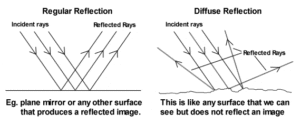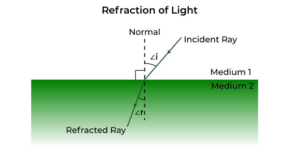In this article, we will discuss in detail the laws of reflection of light class 12, so let’s get started.
Previously, we discussed reflection and its types, viz., diffuse reflection, specular reflection, and retroreflection. If you don’t know about them, you should read this.

There are two laws of reflection:
- First law of reflection
- Second law of reflection
Some basic terminologies
Before we understand the laws, we need to know some basic terms that will help us understand them better. You can jump to the laws of reflection if you already know these terms.
Incident ray
The ray of light that falls on the surface is called an incident ray. The left-hand ray in the diagram is the incident ray.
Reflected ray
The ray of light that bounces back after colliding with the surface is called a reflected ray.
Normal line
The line that is drawn perpendicular to the surface of the plane at the point of incidence is called a normal line. The normal line makes an angle of $90^{\circ}$ with the surface at the point of reflection.
Angle of Incidence
The angle between the incident ray and the normal ray is called the angle of incidence.
Angle of Reflection
The angle between the normal ray and the reflected ray is called the angle of reflection.
Since you are familiar with the basic terminologies of reflection, now we will discuss the laws of reflection.
First law of Reflection
The first law of reflection states that the angle of incidence is equal to the angle of reflection, i.e., $\theta_1 = \theta_2$, where $\theta_1$ is the angle of incidence and $\theta_2$ is angle of reflection.

For example, if an incident ray makes an angle of $45^{\circ}$ with the normal ray (a line perpendicular to the surface at the point),. The reflected ray would also make an angle of $45^{\circ}$ with the normal ray.
Second law of reflection
The incident ray, the reflected ray, and the normal at the point of incidence all lie in the same plane.

As you can see in the above figure, the incident ray, the normal ray, and the reflected ray all lie on the same plane or surface.
Read More:
- Behaviour of light at the interface of two media
- Optics: definition, types, and applications, class 12
- Simple microscope Class 12, Definition, Magnification, working, Parts And Uses
- Reflection of light class 12: definition and types
Conclusion
In conclusion, when an incidence ray of light falls on any plane-reflecting surface, it gets reflected. The light ray that is incident and the light that gets reflected follow some rules. These rules are called the laws of reflection.
There are two laws of reflection: first, the angle of incidence is equal to the angle of reflection, and second, the incidence ray, the reflected ray, and the normal line at the point of incidence all lie on the same plane.
Stay tuned with Laws Of Nature for more useful and interesting content.








